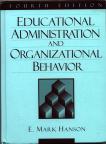Education Administration 615
Public School Organization and Management

Outline of Contingency Theory Presentation
by Brad Linder and Frances Dendy

(The bulk of the information presented here came from our textbook,
Educational Administration and Organizational Behavior by E. Mark Hanson)
Contingency Plan - A Definition:
alternate responses to influence relationship between situations and outcomes
How they work:

Important Concepts
force = intensity of disturbance
target = focus of discontent
source = who is discontented
Basic Assumptions
- middle ground exists
- many goals, sometimes contradictory
- organizations are open systems
- performance is based on external requirements AND internal processes
- basic function is "co-alignment of institutionalized action"
- no one best way
- different management approaches okay
- different leadership styles okay
- initiation of situation - "never get to a problem at its beginnings"
- managers donít have all the information
- One Last Basic Assumption:
ALL EDUCATIONAL ORGANIZATIONS ARE LOOSELY COUPLED SYSTEMS
"Loose coupling permits an educational organization to make adaptive movements in several different directions by focusing on various problems at the same time." (Hanson, p. 137)
Three Orientations of Contingency Theory
- organizational structure and environment
- problem-solving in organized anarchies
- managerial work behavior
First Orientation - Organizational Structure & Environment
Two Organizational Structures
mechanistic
centralized decision-making; hierarchical
good for stable situations/predictable conditions
organic
shifting centers of communication & decision-making
effective for changing conditions
Discussion
Rowan, et.al. found that organic management did NOT lead to more job-related learning.
What do you think?
Importance of Environment
environment affects organization
organization affects environment through:
advertising
contracting
coalescing
lobbying
boundary spanning
Second Orientation - Problem-Solving in Organized Anarchies
Organized Anarchies
goals are ambiguous
technology of action is unclear
fluid participation of members
Problem Solving in these Organized Anarchies
problems/solutions/fluid participation
"garbage can" = choice opportunities
~ institutionalized (staff meeting)
~ external effects (firing or resignation)
~ social process (growing awareness)
Third Orientation - Managerial Work Behavior
What Managers REALLY Do
great quantity of work - unrelenting pace
variety, fragmentation, brevity
prefer current, specific issues (closure)
sit between organization / contacts
prefer verbal media
control own affairs
Managerís Work Roles
1. interpersonal
figurehead role
leader role
liaison role
2. informational
nerve center role
disseminator role
spokesman role
3. decisional
entrepreneur role
disturbance handler role
resource allicator role
negotiator role
No Specific Educational Administration Contingency Theories Exist
11 research questions posed
Some Other Current Views on Contingency Theory
John Cochren's model to assist educational leaders to manage change:
"Contingency theory, which focuses on the interaction among the leaders' personal traits, behavior, and situational factors for effective leadership, is advocated as a useful approach for managing change."
Rondinelli et. al.
Published a book focusing on applying contingency theory in planning education improvement programs in developing countries and for selecting appropriate management strategies to implement them.
Other Sources
- Cochren, J.R. (1995). A Conceptual Model to Assist Educational Leaders Manage Change.
- Kelley, C. and Protsik, J. (October 1997). Risk and reward: perspectives on the implementation of Kentucky's school-based performance award program. Educational Administration Quarterly, (4), 33. 474-505.
- Rondinelli, D.A. and others. (1990). Planning Education Reforms in Developing Countries: The Contingency Approach. Duke University Press.
- Rowan, B. and others. (November 1993). Teaching as a nonroutine task: implications for the management of schools. Educational Administration Quarterly, (4), 29. 479-500.

| Main Home Page | Graduate Work Home Page |



